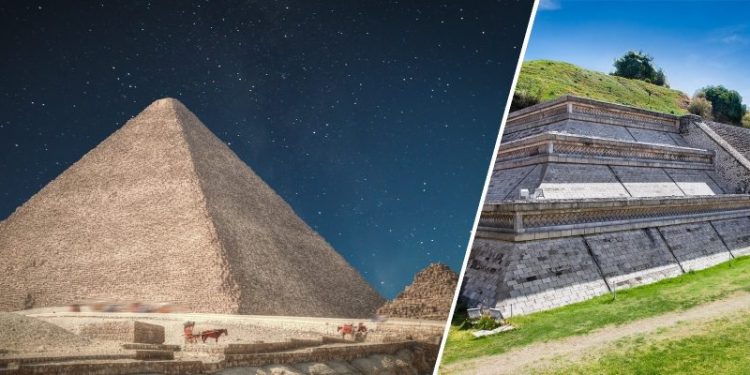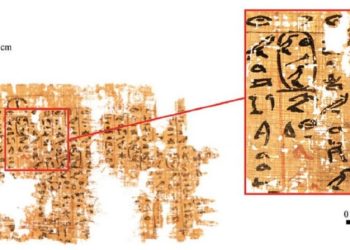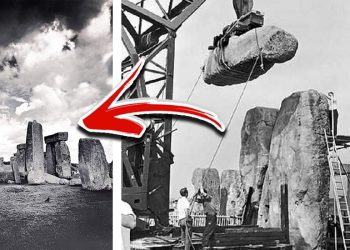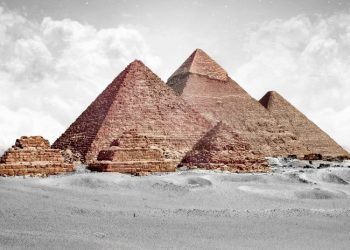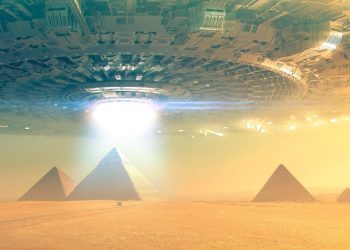The most famous pyramid on the planet’s surface is, without a doubt, the Great Pyramid of Giza. According to Egyptologists, this ancient wonder of engineering is thought to have been completed some 4,500 years ago, during the Fourth Dynasty reign of King Khufu. It wasn’t Egypt’s first, but its most complex and largest, marking the zenith of Egyptian architecture. The journey to building it is as stunning as the Great Pyramid, a monument weighing around 6 million tons. I have previously explained the history of Egyptian pyramids (according to mainstream Egyptology). I won’t explain in this article, but you can check out what I wrote here.
The History of Egyptian Pyramids
The history of the Egyptian pyramid can be traced back to the Third dynasty reign of Djoser when everything about ancient Egyptian architecture was redesigned. Perhaps unwillingly, Djoser’s royal architect Imhotep planned, designed, and went on to build a monument that had never before been witnessed in ancient Egypt. Djoser’s stepped monument is thought to have started as a square mastaba and was gradually enlarged in as many as six distinct constructions across 19 years. A square mastaba was changed into a rectangular one and again into the first square design of the pyramidal structure. After six superimposed mastabas, the proto-pyramid was finished, and Egypt’s first stepped pyramidal structure was born.
What followed was strange; a Step Pyramid would never again be built, although there are indications that a few Pharaohs after Djoser had attempted to replicate Djoser’s Stepped monument complex. Then, in the Fourth Dynasty, when Sneferu took the throne of Egypt, a Pyramidomania began in Egypt. Sneferu is credited with having built three major pyramids. Egyptologists say Sneferu commissioned the Pyramid at Meidum and the Bent and Red Pyramid at Dahshur. Eventually, he would lay down the foundations for the construction of the Great Pyramid with his Red Pyramid, Egypt’s third-largest pyramid.
Sneferu’s son Khufu is believed to have commissioned the Great Pyramid early in his reign. Its construction is thought to have taken between 10 to 20 years, depending on which “expert” you consult. Below, I will lay down the characteristics of the Great Pyramid, then the Great Pyramid of Cholula—the largest on Earth, as well as their similarities and differences.
Although it is the largest in Egypt, the Great Pyramid of Giza is not the largest on Earth, although it is the tallest ever built. Just as the monument of Djoser was built in stages, the Great Pyramid was likely too built in different phases during which the strcuture was enlarged.
Cholula and Giza
As I have explained in this article, there is direct evidence that the Great Pyramid of Giza may have started as a much smaller pyramid and was enlarged thrice during history. This makes sense as building such a massive pyramid would have been particularly challenging—although not impossible—in ancient times. The first addition to the Great Pyramid would have occurred after the first pyramid chamber was completed.
Measurements of the pyramid suggest that the builders used approximately 2.3 million stone blocks. Experts believed they used 5.5 million tons of limestone, 8,000 tons of granite (imported from Aswan), and 500,000 tons of mortar. It is particularly interesting to know that the granite was imported from Aswan’s quarries located over 800 kilometers away in Upper Egypt. Some of the heaviest stones used to construct the pyramid—the granite blocks inside the King’s chamber weigh 25 to 80 tons.
The Great Pyramids Total Volume
With a base length of 230.34 meters (756 ft) or 440 Egyptian Royal cubits, the Great Pyramid has a total volume of 2,583,283 cubic meters (91,227,778 cu ft. When it was completed, and with its capstone in place, it is believed to have had a height of 146.7 meters (481 ft) or 280 Egyptian Royal. Today, void of its summit, the Great Pyramid measures 138.8 meters in height. The Great Pyramid was covered in highly polished limestone blocks, which are thought to have been quarried at Tura, across the Nile River, and transported via boats to Giza. This means that the Great Pyramid was a “white” pyramid and was probably covered by a golden capstone. The white limestone made the pyramid shine brightly during the day.
Khufu’s pyramid has three known chambers; the subterranean, unfinished chamber, the Queen’s Chamber, and the King’s Chamber. The builders also constructed the so-called Grand Gallery. In 2017, the ScanPyramids project discovered the existence of another previously unnoticed chamber just above the grand gallery. This room has still not been explored. Although not all pyramids in Egypt were tombs (Check the provincial pyramids and the last Egyptian pyramid, for example), Egyptologists believe that the Great Pyramid of Giza was intended to serve as the eternal resting place for King Khufu. It is noteworthy to mention that Khufu’s mummy has never been found.
Tlachihualtepetl, the Real Great Pyramid
Although certainly one of Earth’s most fascinating ancient monuments, the Great Pyramid has some serious competition. For starters, it isn’t the largest pyramid on Earth. This honor belongs to a pyramid built in present-day Mexico and is referred to as Tlachihualtepetl, which means “made-by-hand mountain” in Nahuatl. More commonly referred to as the Great Pyramid of Cholula, this massive “manmade mountain” stands at a height of 55 meters. Experts acknowledge it as the largest archaeological site of a pyramid anywhere in the New World and the largest pyramid on the planet by volume.
Unlike the Great Pyramid, which is believed to have served as a tomb, Cholula was built in honor of the Mesoamerican feathered serpent deity Quetzalcoatl and served as a temple. With a base of 450 by 450 meters, the Guinness Book of World Records has the Cholula as the largest pyramid and monument ever constructed worldwide. Compared to its counterpart at Giza, which has a total volume of around 2.5 million cubic meters, the massive monument at Cholula has a total volume estimated at over 4.5 million cubic meters, meaning it is near twice the size of Giza’s Great Pyramid.
Great Pyramid of Cholula
Although the Great Pyramid is thought to have been completed in ten or twenty years, some academics believe that the Great Pyramid of Cholula took centuries to build. Researchers say that one thousand years before the conquest of the New World, consecutive construction phases built the bulk of the pyramid until it became the largest in Mesoamerica and the world. Different cultures may have contributed to completing the massive monument at Cholula, while only the Egyptians built the behemoth structure at Giza.
There aren’t any plans, blueprints, or mentions of how neither of the two monuments were built. No records from their initial construction phase exist. Nonetheless, legends say that the Great Pyramid of Cholula was built by Xelhua, one of the seven giants of Aztec Mythology. Unlike its counterpart in Giza, which was covered in finely polished limestone, the ancient inhabitants of Cholula buried the entire monument before the arrival of the Spanish, hoping to safeguard it from destruction. Their plan worked, and the Spanish never found the pyramid and even built a church on top of the hill.
Similarities and differences
The Great Pyramid of Giza is considered the perfect smooth-sided structure built in ancient times. On the other hand, the monument at Cholula is a stepped structure composed of six superimposed platforms (similar to that of Djoser). Each structure is believed to have been built by the ethnic group that controlled it. Of the six, only three have been studied in detail. The base of the Great Pyramid of Cholula covers a stunning 160,000 square meters, three times the size of the 53,056.5 square meter base of Pharaoh Khufu’s monument.
The Great Pyramid of Cholula suffered extensive damage during the Colonial period, while the Great Pyramid of Giza may have been damaged by earthquakes and forced entry. The Great Pyramid of Cholula has a network of tunnels beneath it, while the Great Pyramid only has an unfinished chamber. In a sense, the Great Pyramid of Cholula, for me, personally, is more similar to Djoser’s Step Pyramid at Saqqara than to the Great Pyramid of Giza. Djoser’s Pyramid and that of Cholula were Stepped pyramids in their own way, and both were built across various stages. Furthermore, I believe that the Great Pyramid of Cholula represents the initial and final form of the pyramid form in Mesoamerica, with the Pyramids of Teotihuacan being its closest evolution.
Have something to add? Visit Curiosmos on Facebook. Join the discussion in our mobile Telegram group.



